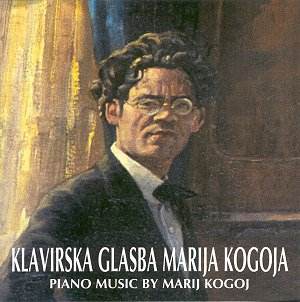 Composer: Marij Kogoj
Composer: Marij Kogoj
Works: Suite: ‘Piano’, Chopiniana, 22 Bagatelles
Performers: Bojan Gorišek (piano)
Recording: Rec 1998?, DDD SAZAS DD 0292 (54:00)
Label: Sazas
Marij Kogoj, a figure often overshadowed by his contemporaries, emerges as a significant yet underappreciated voice in early 20th-century music. Trained under the tutelage of Arnold Schoenberg and Franz Schreker, Kogoj’s oeuvre predominantly revolves around piano music, interspersed with songs and chamber works. His career, tragically curtailed by mental illness after 1932, left behind a body of work that reflects a unique blend of folk-inspired late Romanticism and nascent expressionism. The present recording, featuring Bojan Gorišek, presents a curated selection of Kogoj’s piano compositions, inviting listeners to explore the nuanced textures of this Slovenian composer’s voice.
The Suite titled simply ‘Piano’ (1921), represents Kogoj’s early style, which is characterized by a lyrical quality that is at times understated. The first three movements—Andante cantabile, Allegretto, and Andante poco più mosso—while pleasant, lack the dramatic intensity that later defines his work. They exhibit a melodic charm reminiscent of late Romanticism, yet do not significantly distinguish themselves within the broader context of the genre. It is in the fourth movement, Skica (“Sketch”), where Kogoj’s compositional maturity begins to emerge. The succinctness and clarity of this movement suggest a deeper exploration of thematic material and emotional depth. The subsequent Andantino sostenuto and Più mosso further confirm this trajectory, unfolding with a more pronounced sense of urgency and complexity.
Gorišek’s performance is both sympathetic and technically astute, capturing the understated elegance of Kogoj’s writing. However, the piano tone, at times, presents challenges; it often comes across as hard-edged, lacking the warmth that could elevate the lyrical passages. This issue is particularly apparent in the Chopiniana in G minor, where Kogoj’s homage to Chopin’s nocturnes shines through, but is somewhat dimmed by the piano’s ungrateful timbre. The 22 Bagatelles, or “Malenkosti”, composed during a visit to Slovenia’s rural Dolenjska district, are perhaps the most engaging part of the recording. Here, Kogoj’s ability to encapsulate folk elements within a miniaturist framework is reminiscent of Szymanowski’s pastoralism, while avoiding the overt percussiveness of Bartók.
The engineering of the recording, produced by Slovenian Radio & TV, is competent yet does not fully exploit the potential richness of Gorišek’s interpretations. The sound, though clear, lacks the depth and resonance that could enhance Kogoj’s intricate textures. This limitation slightly detracts from the overall experience, particularly in passages that demand a more vibrant sound palette.
Bojan Gorišek’s interpretations reveal an artist grappling with the subtleties of Kogoj’s language, making this recording an essential entry point into the composer’s work. While it does not present the composer’s oeuvre in the most favorable light due to tonal limitations, it does succeed in highlighting Kogoj’s unique compositional voice. The recording merits attention for both its historical significance and its role in bringing Kogoj’s music to a contemporary audience. This disc opens a valuable dialogue about a composer whose work deserves further exploration and recognition in the canon of early 20th-century music.



